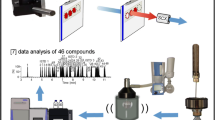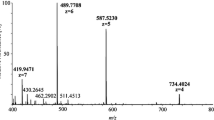Abstract
There is significant evidence that athletes are using recombinant human growth hormone (rhGH) to enhance performance, and its use is banned by the World Anti-Doping Agency and professional sports leagues. Insulin-like growth factor-1 (IGF-1) is the primary mediator of growth hormone action and is used as a biomarker for the detection of rhGH abuse. The current biomarker-based method requires collection and expedited shipment of venous blood which is costly and may decrease the number of tests performed. Measurement of GH biomarkers in dried blood spots (DBS) would considerably simplify sample collection and shipping methods to allow testing of a greater number of samples regardless of location. A method was developed to quantify intact IGF-1 protein in DBS by liquid chromatography–tandem mass spectrometry. A step-wise acid–acetonitrile extraction was optimized to achieve a sensitive assay with a lower limit of quantification of 50 ng/mL. IGF-1 remained stable at room temperature for up to 8 days, which would allow shipment of DBS cards at ambient temperature. In a comparison between plasma concentrations of IGF-1 and concentrations measured from venous and finger prick DBS, there was good correlation and agreement, r 2 of 0.8551 and accuracy of 86–113 % for venous DBS and r 2 of 0.9586 and accuracy of 89–122 % for finger prick DBS. The method is intended for use as a rapid screening method for IGF-1 to be used in the biomarker method of rhGH abuse detection.






Similar content being viewed by others
References
Holt RI, Erotokritou-Mulligan I, Sonksen PH (2009) The history of doping and growth hormone abuse in sport. Growth Horm IGF Res 19:320–326
Bidlingmaier M, Suhr J, Ernst A, Wu Z, Keller A, Strasburger CJ, Bergmann A (2009) High-sensitivity chemiluminescence immunoassays for detection of growth hormone doping in sports. Clin Chem 55(445–453):13
Kniess A, Ziegler E, Kratzsch J, Thieme D, Muller RK (2003) Potential parameters for the detection of hGH doping. Anal Bioanal Chem 376:696–700
Powrie JK, Bassett EE, Rosen T, Jørgensen JO, Napoli R, Sacca L, Christiansen JS, Bengtsson BA, Sönksen PH (2007) Detection of growth hormone abuse in sport. Growth Hormone & IGF Research 17:220–226
Erotokritou-Mulligan I, Bassett EE, Cowan DA, Bartlett C, McHugh C, Sonksen PH, Holt RI (2009) Influence of ethnicity on IGF-I and procollagen III peptide (P-III-P) in elite athletes and its effect on the ability to detect GH abuse. Clin Endocrinol (Oxf) 70:161–168
Erotokritou-Mulligan I, Bassett EE, Bartlett C, Cowan D, McHugh C, Seah R, Curtis B, Wells V, Harrison K, Sonksen PH, Holt RI (2008) The effect of sports injury on insulin-like growth factor-I and type 3 procollagen: implications for detection of growth hormone abuse in athletes. J Clin Endocrinol Metab 93:2760–2763
Guha N, Erotokritou-Mulligan I, Burford C, Strobridge G, Brigg J, Drake T, Bassett EE, Cowan D, Bartlett C, Sonksen PH, Holt RI (2010) Serum insulin-like growth factor-I and pro-collagen type III N-terminal peptide in adolescent elite athletes: implications for the detection of growth hormone abuse in sport. J Clin Endocrinol Metab 95:2969–2976
Holt RI, Erotokritou-Mulligan I, McHugh C, Bassett EE, Bartlett C, Fityan A, Bacon JL, Cowan DA, Sonksen PH (2010) The GH-2004 project: the response of IGF1 and type III pro-collagen to the administration of exogenous GH in non-Caucasian amateur athletes. European journal of Endocrinology / European Federation of Endocrine Societies 163:45–54
Leger J, Reverchon C, Porquet D, Noel M, Czernichow P (1995) The wide variation in urinary excretion of human growth hormone in normal growing and growth hormone-deficient children limits its clinical usefulness. Horm Res 44:57–63
Gill MS, Toogood AA, O'Neill PA, Thorner MO, Shalet SM, Clayton PE (1998) Urinary growth hormone (GH), insulin-like growth factor I (IGF-I), and IGF-binding protein-3 measurements in the diagnosis of adult GH deficiency. J Clin Endocrinol Metab 83:2562–2565
Thomas A, Geyer H, Schanzer W, Crone C, Kellmann M, Moehring T, Thevis M (2012) Sensitive determination of prohibited drugs in dried blood spots (DBS) for doping controls by means of a benchtop quadrupole/Orbitrap mass spectrometer. Anal Bioanal Chem 403(1279–1289):14
Moller I, Thomas A, Geyer H, Schanzer W, Thevis M (2012) Development and validation of a mass spectrometric detection method of peginesatide in dried blood spots for sports drug testing. Anal Bioanal Chem 403:2715–2724
Alfazil AA, Anderson RA (2008) Stability of benzodiazepines and cocaine in blood spots stored on filter paper. J Anal Toxicol 32:511–515
Therrell BL Jr, Hannon WH, Bailey DB Jr, Goldman EB, Monaco J, Norgaard-Pedersen B, Terry SF, Johnson A, Howell RR (2011) Committee report: considerations and recommendations for national guidance regarding the retention and use of residual dried blood spot specimens after newborn screening. Genet Med 13:621–624
Bredehoft M, Schanzer W, Thevis M (2008) Quantification of human insulin-like growth factor-1 and qualitative detection of its analogues in plasma using liquid chromatography/electrospray ionisation tandem mass spectrometry. Rapid Commun Mass Spectrom 22:477–485
Popot MA, Woolfitt AR, Garcia P, Tabet JC (2008) Determination of IGF-I in horse plasma by LC electrospray ionisation mass spectrometry. Anal Bioanal Chem 390:1843–1852
Nelson RW, Nedelkov D, Tubbs KA, Kiernan UA (2004) Quantitative mass spectrometric immunoassay of insulin like growth factor 1. J Proteome Res 3:851–855
Bystrom CE, Sheng S, Clarke NJ (2011) Narrow mass extraction of time-of-flight data for quantitative analysis of proteins: determination of insulin-like growth factor-1. Anal Chem 83:9005–9010
Kay RG, Barton C, Velloso CP, Brown PR, Bartlett C, Blazevich AJ, Godfrey RJ, Goldspink G, Rees R, Ball GR, Cowan DA, Harridge SD, Roberts J, Teale P, Creaser CS (2009) High-throughput ultra-high-performance liquid chromatography/tandem mass spectrometry quantitation of insulin-like growth factor-I and leucine-rich alpha-2-glycoprotein in serum as biomarkers of recombinant human growth hormone administration. Rapid Commun Mass Spectrom 23:3173–3182
Bystrom C, Sheng S, Zhang K, Caulfield M, Clarke NJ, Reitz R (2012) Clinical utility of insulin-like growth factor 1 and 2; determination by high resolution mass spectrometry. PLoS One 7:e43457
US Department of Health and Human Services FaDA (2001) Guidance for Industry: Bioanalytical Method Validation. http://www.fda.gov/CDER/GUIDANCE/4252fnl.htm.15
Ewles MF, Turpin PE, Goodwin L, Bakes DM (2011) Validation of a bioanalytical method for the quantification of a therapeutic peptide, ramoplanin, in human dried blood spots using LC-MS/MS. Biomed Chromatogr 25:995–1002
Hwa V, Oh Y, Rosenfeld RG (1999) The insulin-like growth factor-binding protein (IGFBP) superfamily. Endocr Rev 20:761–787
Breier BH, Gallaher BW, Gluckman PD (1991) Radioimmunoassay for insulin-like growth factor-I: solutions to some potential problems and pitfalls. J Endocrinol 128:347–357
Blumenfeld TA, Hertelendy WG, Ford SH (1977) Simultaneously obtained skin-puncture serum, skin-puncture plasma, and venous serum compared, and effects of warming the skin before puncture. Clin Chem 23:1705–1710
Yang ZW, Yang SH, Chen L, Qu J, Zhu J, Tang Z (2001) Comparison of blood counts in venous, fingertip and arterial blood and their measurement variation. Clin Lab Haematol 23:155–159
Denniff P, Spooner N (2010) The effect of hematocrit on assay bias when using DBS samples for the quantitative bioanalysis of drugs. Bioanalysis 2:1385–1395
Acknowledgements
This work was supported by the NFL and the NFL Players Association Research and Education Fund.
Author information
Authors and Affiliations
Corresponding author
Rights and permissions
About this article
Cite this article
Cox, H.D., Rampton, J. & Eichner, D. Quantification of insulin-like growth factor-1 in dried blood spots for detection of growth hormone abuse in sport. Anal Bioanal Chem 405, 1949–1958 (2013). https://doi.org/10.1007/s00216-012-6626-y
Received:
Revised:
Accepted:
Published:
Issue Date:
DOI: https://doi.org/10.1007/s00216-012-6626-y




